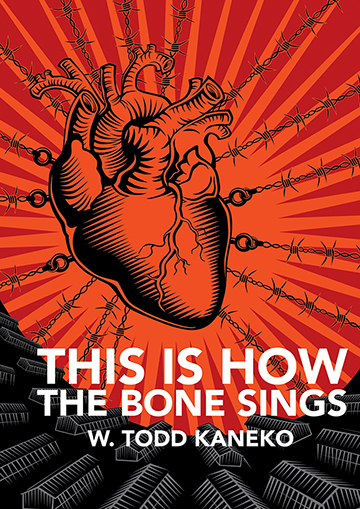This Is How the Bone Sings
This Is How the Bone Sings is a book about silence. These poems are about Minidoka, the concentration camp built in Idaho for Japanese Americans during World War II, drawing from myth and folk tale to talk about the legacy of trauma across multiple generations in America.

buy this book
MINIDOKA WAS A CONCENTRATION
CAMP IN IDAHO
I am afraid that all my ancestors
have gathered my words like birds
collect hair from the dead
for nesting, an abundance of silence,
whole spools of it ready to tether
me to the trees. I am a new father,
too young for ghost stories, too fresh
to remember what it was like to shiver
out on the prairie. I see my own breath,
sometimes when my son cries
at night. He doesn’t have to describe
those things he fears in the dark
because my grandmother told me
the world will never be safe for us
when she refused to say the name
of that place we come from. Minidoka,
I say to him and my ancestors lay
fingers across my lips. Do not be ashamed
because we are alive, because the birds
will one day pluck us clean.
this poem first appeared in Massachusetts Review
Praise for This is How the Bone Sings
“In Kaneko’s highly-anticipated This Is How the Bone Sings, we are introduced to characters mythical and marvelous in landscapes where “…hands can be stealthy, lovesick foxes or tiny owls who doubt the night.” These are much-needed poems of unapologetic tenderness and talent—in other words, this collection does the near-impossible: it points us towards love even if what we know of this world doesn’t.”
— Aimee Nezhukumatathil, Author of Oceanic and Lucky Fish
“What does it mean to be safe in America? In This Is How the Bone Sings, W. Todd Kaneko explores the legacy of concentration camps in the United States and how memory is carried forward. Brilliant and inventive in its use of form, Kaneko weaves in haikus as sentences and haibun as reading comprehension quizzes. Reaching into myth and ancestry, these poems pull out rich narratives and lyricism, where even in the most brutal pasts, horses whisper truths and a boy is born of a peach. Kaneko interrogates a nation with its own language and with places it has almost erased. This book knows how to sing—to America, not its expected script, but the anthems of its history; and to a son, lessons on how to bring back the dead with stories, with a fading map, with birds.”
— Traci Brimhall, Author of Come the Slumberless to the Land of Nod
The best books about history are those that are also about the future. W. Todd Kaneko’s marvelous This is How the Bone Sings is more than a mere song—it is a singing across time and distance. In lyrics both personal and political, Kaneko composes a score that spans four generations, connecting his grandparents, who were prisoners in the unfathomable Minidoka concentration camps, to his young son and this unfathomable era in which he was born. One of the many things I love about this book is Kaneko’s willingness to ask big questions: what lessons about the present can we learn from the past? What is the inheritance of trauma? Can anything not be repeated? Ultimately, though, it is the craft of these poems that converts the experiences of history into the experience of art. This is a must read.
— Dean Rader, Author of Self Portrait as Wikipedia Entry
In a lyric collection of profound beauty and grief, This Is How the Bone Sings by W. Todd Kaneko carries the pulse of ancient lament through the boneyards of war and unspeakable trauma. Kaneko’s powerful songs of ancestral fatherhood illuminate the haunting melancholia of exile and internment: “When I dream, I see an open meadow / from my father’s living room / windows, the house drained of color / except for the dissolve of night, / a splash of fire, an angel’s mane / untamed for the first time / since suffering a gash of spurs.” The graceful poems hover in the air like elusive promises of hope overshadowed by heartache, loss, and betrayal persisting long after a time of war: “We believe not in ghosts but in flowers, / in the shape of a blossom that appears / every spring and whispers that word / our family uses in the place of ghosts.” In a world at once beautiful and grotesque, the poet must “hew an orchard out of the night” as a space of survival. This Is How the Bone Sings reminds us to share our tales of generational trauma and topography—shaping our individual and collective memories – in place of forgotten histories.
– Karen An-hwei Lee, Author of The Maze of Transparencies
To enter this book is to enter an orchard alive with memory’s beasts. To read This Is How the Bone Sings is to witness how a poet at the height of his powers can alchemize history’s violence into lyric and myth. W. Todd Kaneko’s gutting and transformative collection begins in Minidoka, the site of his family’s incarceration, and travels far beyond it: to lands where ogres roam, where witches wander midnight trees, where a grandmother’s ghost haunts an arrow-shadowed house. As yonsei (fourth generation Japanese American) poets, we wonder often—to ourselves, to each other—how to respond to our children’s “carnivorous question”: Where is Minidoka? Minidoka: site of survival and confinement, the place where our country practiced “how to kill people / without killing them,” the desert prison where “our families learned to be beasts.” Minidoka: our collective nightmare, our ghosts’ shared dream. This Is How the Bone Sings returns me to the deep ancestral howl crying out from our communal histories; it also returns me to my humanity.
— Brynn Saito, Author of Power Made Us Swoon